Begonia is a very large genus containing more nearly 2,000 annual, perennial, and woody shrub species native to tropical and subtropical climates around the world. They are typically used as houseplants and in shaded summer beds. Some are grown for their asymmetrical, patterned and variegated foliage, and others to add color to shady garden areas with their bright blooms. Although typically on the smaller side, begonia plants pack a big punch of color and interest.
Many begonias are suited best to outdoor culture, and are generally grown from underground root structures referred to tubers. Begonias are grown as annual flowers, filling space between perennials or adding life to decks and patios in pots. Among the thousands of available varieties of begonia, almost 95% require easy care. In this article we discuss the most common varieties of Begonia.
1. Tuberous Begonias

Tuberous begonias (Begonia tuberosa) add bright color and attractive green foliage to shady, well-drained areas of the garden. Tuberous varieties grow from a swollen root tuber, which stores energy and nutrients for the plant through the summer growth period. The flowers remain in bloom for most of summer and into fall, requiring only minimal maintenance when planted in the correct location.
Tuberous begonias are popular for their beautiful flowers that come in a variety of colors and forms. Red, orange, yellow, white, salmon and pink blooms may be single or double and may be plain, ruffled or toothed. Their petals may have margins, crests or blotches of contrasting color.
Tuberous begonias bloom throughout the summer, thriving in shady spots where few other plants with long bloom periods and showy flowers can grow. They are often used as container plants on patios and porches, in hanging baskets, and as bedding plants.
Tuberous begonia species are native to tropical South America and southern Africa. Most varieties available in garden centers or though catalogs are hybrids with complex parentage, but all share the same growing requirements.
2. Semperflorens Begonias

Begonia semperflorens-cultorum was named for its long bloom period, from semperflorens, meaning ‘ever-blooming’. The common name, wax begonia, refers to the waxy sheen of the leaves. The genus was named in honor of Michel Bégon (1638-1710), a French amateur botanist who collected begonias from while he was stationed in Santo Domingo with the French navy.
The wax begonia group, categorized as Begonia x semperflorens or Semperflorens Cultorum Group, comprises varieties used primarily as bedding annuals, though they are technically warm-weather perennials. These fibrous-rooted plants have a compact, bushy mounded shape with flesh stems, dark green or bronze waxy leaves, and loose clusters of flowers that bloom all summer and into fall.
Wax begonia is one of the most popular bedding plants in landscaping. Innumerable flats of these sturdy plants are poked into the soil every spring to create lush beds of flowers. The reasons for this heavy use are obvious—they’re durable, ever-blooming plants that provide sweeping color in single or double blooms.
Wax begonias are normally planted in the spring from bedding flats or potted plants started in a greenhouse environment. They can also be planted from seeds, though the plants are quite slow-growing at first, and it can take several months for them to mature to flowering plants. For this reason, seeds are usually started indoors about 12 weeks before the last expected frost.
3. Cane-like Begonias
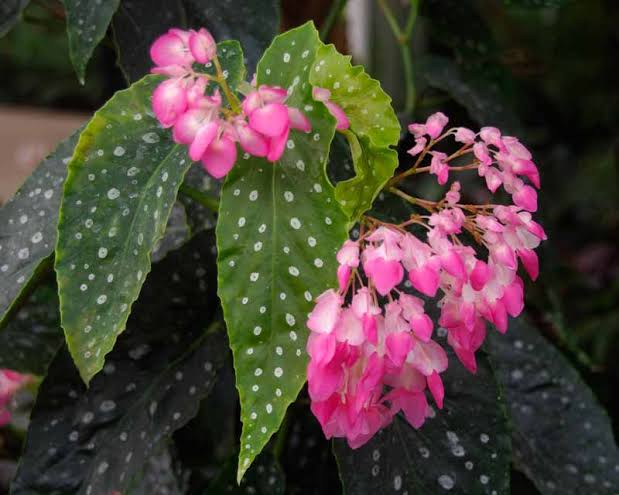
Cane-like begonias have tough, bamboo-like stems and are prized for their strikingly patterned leaves, and many feature attractive and fragrant flowers as well. Cane-like begonias have long stems with slightly swollen joints (“nodes”)-they resemble bamboo. The leaves and flowers arise from the joints. With optimum care, some cultivars can reach six feet or more in height in a container, as much as 15 feet or so in the ground in mild winter areas. Others remain short enough for indoor culture. Cane-like begonias are grown for both foliage, which sometimes is spotted or textured, and flowers, usually large, cascading clusters of white, pink, red, or orange, for a large part of the year. Timing varies from variety to variety.
Most cane-like begonias are not fussy about temperature or humidity. Any range that is comfortable for people is fine. If leaves brown and get crisp on the edges, the humidity is too low. If leaves yellow and fall off, you are watering too often. These begonias rarely need staking, but require pruning in winter or early spring: remove old, woody canes and shorten green ones to about four or five nodes, some canes longer and others shorter. (New canes just starting should be left alone.) Repot into fresh mix at the same time.
4. Rex Begonias (Begonia Rex-cultorum)
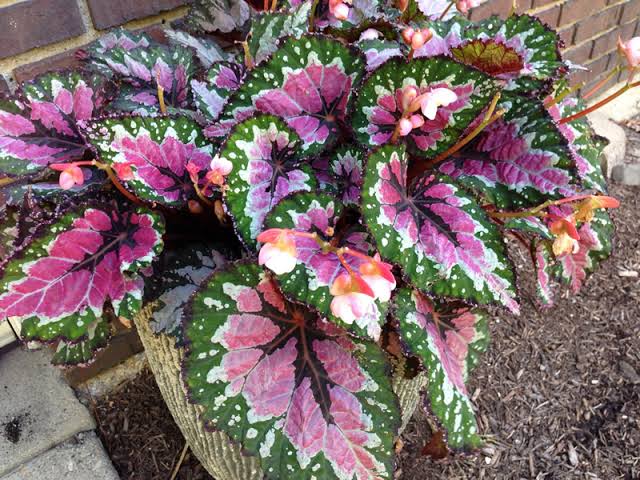
A Begonia Rex plant, also called a Painted-Leaf Begonia, a Fancy-Leaf Begonia, or King Begonia, is among the various types of begonias, Rex Begonia (which is part of the rhizomatous begonias) is one of the most beautiful and stunning plants and are favored not for their flowers, but for their interesting foliage. Sometimes called painted-leaf begonias or fancy-leaf begonias, these plants are known for their showy, sometimes jaw-dropping leaf coloration and patterns. They frequently have large leaves that are brightly colored in various shades of green, red, silver, and even purple. The leaves of Rex Begonias can grow up to 9 inches long and 5 inches across, while the plants normally reach heights of 1 to 1 1/2 feet tall. These plants are grown almost exclusively for their interesting foliage—their blooms tend to be small and less showy, so many growers pinch off blooms to maintain breathtaking leaf displays. Some types of Rex Begonias go into dormancy during the winter.
5. Hiemalis Begonia
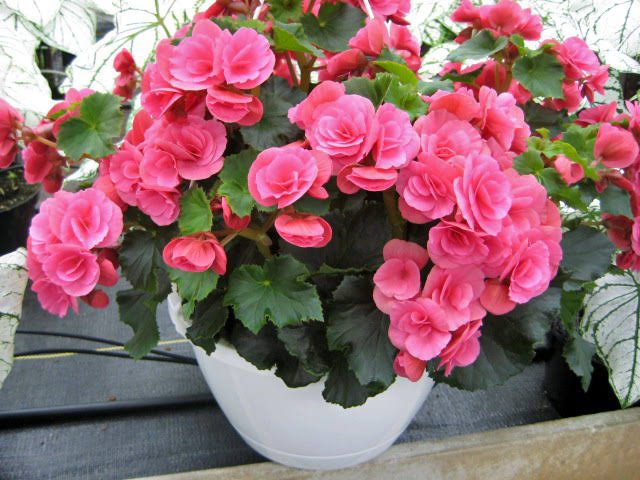
The Hiemalis begonia (Begonia x hiemalis), a cross between a wax begonia and a tuberous begonia, is prized for its waxy green foliage and the brightly colored flowers that bloom profusely from spring until autumn. This sturdy, easy-care annual reaches heights of 10 to 12 inches, with a spread of 10 to 12 inches. Also known as Rieger begonia, the Hiemalis begonia is suitable for planting in containers, hanging baskets or flower beds in U.S. Department of Agriculture plant hardiness zones 9 to 11.
6. Trailing-Scandents

Trailing-scandent begonias grow vine-like, usually with many branches, and lend themselves superbly to hanging baskets or being trained up posts, trellises, and “totem poles.” Most are packed with small leaves and bloom in clusters more or less profusely, the flowering season varying from plant to plant.
These begonias are good subjects to grow hanging from tree limbs, under lath covers or greenhouse roofs, and in front of large windows. These begonias need plenty of light, even some sunlight, but no intense midday sun. Good light will help produce a full plant with lots of bloom. If leaf stems elongate and the space between stem joints gets larger, you know the plant needs more light. if the foliage pales, you are providing excessive light. The usual comfortable temperature range for people, 58 to 72 degrees F., is right for trailing-scandent begonias. The humidity requirement is average for begonias — 40 to 60 percent or so.
7. Shrub-like Begonias

Shrub-like begonias get their name from the way they grow with many shoots coming up from the soil to make a full plant. They are very multi-stemmed, in other words, they have a well-branched, upright shape and grow vigorously. Most varieties do not bloom as often or as heavily as the cane-like begonias but some are ever blooming and are used as bedding plants across the country. The shrub type is grown mostly for its ease of growing; interesting leaves, and full growth. Most shrubs have white flowers but there are plenty of pink and red ones also, and many have hairy flowers.
They bloom profusely from October onwards, all through summer and autumn, even into winter in mild suburbs. Some flower literally all year. They seem to be at their very peak around March. They are drought- and heat-tolerant, bloom well in semi-shade and can all be grown in pots as well as in the garden. They are excellent for flower arrangements, lasting for ages in a vase. There are over 300 species and cultivars grown in gardens today. Most of the species originated in Central and Southern America and seem perfectly suited to Sydney’s climate.
8. Elatior Begonias

The Elatior Begonia is a hybrid made by an English plant breeder James Veitch back in 1883. It’s a crossbreed of two species—Begonia socotrana and a tuberous begonia type. The Begonia socotrana natively comes from Scootra, an Island a few miles away from East Africa’s coastline, while the latter was found in the tropical regions of South America.
Elatior begonias (Begonia x hiemalis) adorn homes across much of the United States, as these flowering plants are available year-round from florists and greenhouses. Typically grown as a summer annual, this plant can be grown outside in a sheltered location where temperatures range from 50 to 75 degrees Fahrenheit.
9. Thick-stemmed Begonias

The thick-stemmed types are not as widely grown but come in various forms. They all have very thick stems. Most thick-stemmed types don’t branch much but send up new growth from the base. They also show off the thick stems because they drop their lower leaves and usually only have leaves on the tips.
The thick-stemmed begonias rarely branch – instead, they produce new stems from the base to replace old, woody, spent ones. With a few exceptions, they are seasonal bloomers if they bloom at all. Some bloom very sparsely, even in good cultural conditions. Leaves can be bare or hairy, depending on the plant.
These begonias require lots of sun to grow large and as full as possible, although intense sun in hot areas is to be avoided. Their temperature requirements are flexible. Almost any range comfortable to humans will do. In temperatures near freezing, however, many kinds will go dormant, dropping leaves and suspending growth. Thick-stemmed begonias need no special high-humidity conditions — a range of 40 to 50 percent is sufficient.
Because of their tendency to grow tall without branching, it often is difficult to train thick-stemmed begonias into compact, pleasing forms. Stake a stem that is going askew or that is drooping when it is supposed to grow erect. Pruning consists primarily of removing old, bare stems to make room for new, green, vigorous ones as they appear. Pinching new stems is the way to force side growth and control plant height.
10. Rhizomatous Begonias
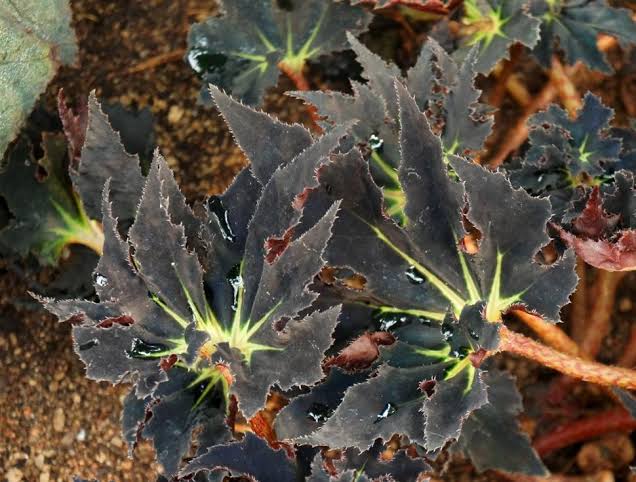
Rhizomatous begonias are a large group of Begonia species, hybrids and selections characterized by large, sometimes-colorful leaves arising from thick, fuzzy stem-like structures or rhizomes that grow along the soil surface. Because the plants store water in the rhizomes, they are tougher and more tolerant of neglect than other types of begonias. Depending on the variety, rhizomatous begonias range from demure plants with 1-inch leaves to plants large enough to require a wide, sturdy container.
Flowers occur in late winter to spring, depending on the species, cultivar and weather, and are quite showy on some selections. Flowers typically are white to various shades of pink and occur in a cluster (technically called a cyme) held above the foliage, in some cases dramatically high above the foliage. Individual flowers may range in size from 3/8-inch to over 2 inches at their widest point and a flower cluster may contain a few to over 120 individual flowers, depending on selection and growing conditions. Although it is often grown as an indoor plant, rhizomatous begonia is suitable for growing outdoors in U.S. Department of Agriculture hardiness zones 10 and 11. Some types are used in north Florida as herbaceous perennials that add bold leaf texture and color as well as flowers to shady gardens.
11. Dragon Wing Begonias
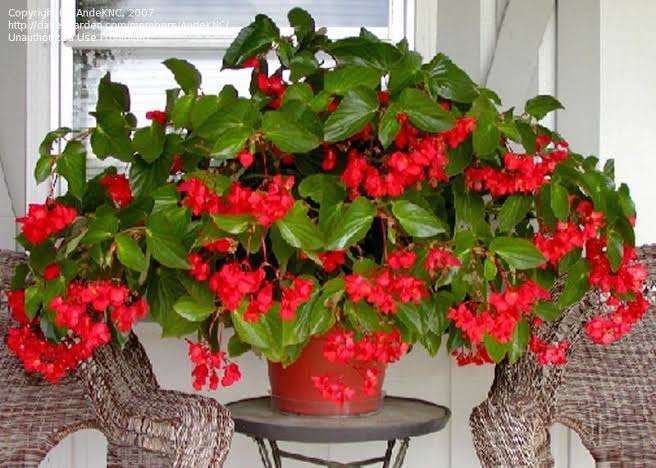
Dragon wing begonias (Begonia x argenteoguttata) are a flowering perennial plant, hybrid of the angel wing and wax begonias. They are vigorous growers, reaching up to 2 ft (60 cm) tall — and will spread about as wide. This hybrid variety has a longer blooming period than other cultivars of this plant family and can grow up to 3 feet tall. The flowers of the dragon wing begonia plant are usually pink, white or red, but may be seen in other colors. However, Red is the most common flower color seen on the dragon wing begonia. The heat tolerant flowers appear at the tip of the branches in clusters. Dragon wing begonias have larger leaves and flowers than other begonia varieties. The plant is also self-pruning, meaning old flowers will naturally shed as new ones appear.
12. Double Begonias
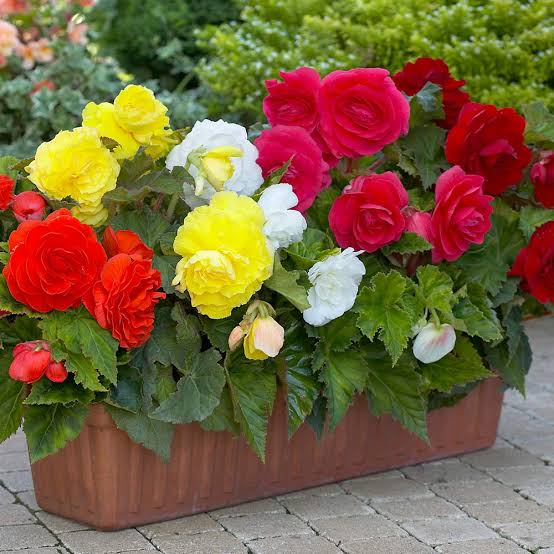
Double begonias (Begonia semperflorens) brighten up patio planters, window boxes and garden beds with showy double blossoms. These low-growing annuals are ideal as a bedding plant. They grow from 6-to-18 inches tall and flower from early summer through the first frost. Double begonias are the same species as singe flower begonias. Double begonias are cultivated varieties that have flowers with double sets of flower petals. Other common names are wax begonia and bedding begonia.
13. Begonia ‘Hanging Basket Scarlet’
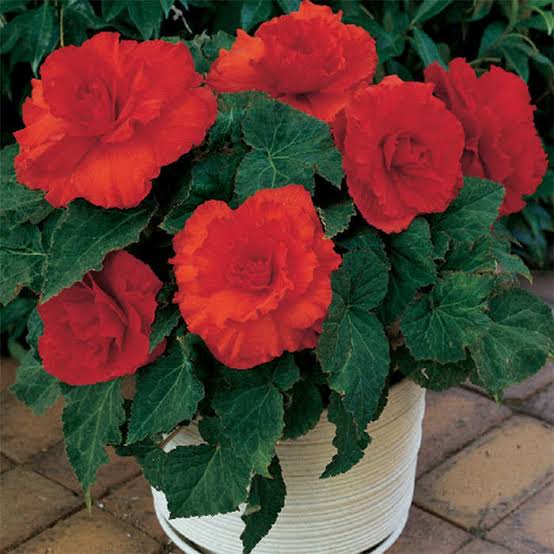
Free-flowering Begonia ‘hanging basket scarlet’ is a tuberous perennial boasting attracting cascades of extra-large, 2-5 inches, fully double, brilliant scarlet-red flowers. Blooming profusely from late spring to frost, they dangle with elegance from arching stems bearing green fleshy leaves adorned with serrated edges. The excellent branching habit of this tuberous begonia results in a superb floral display. It is a wonderful shade loving plant for containers and hanging baskets.
14. Begonias ‘Giant Picotee Mixed’

Begonia ‘Giant Picotee Mixed’ is an upright, tender perennial with large and magnificent, semi-ruffled white flowers, up to 4-8 inches, adorned with bright pink petal tips. Begonia ‘Giant Picotee Mixed’ is perfect for growing in pots and hanging baskets and thrives in full sun to partial shade.
15. (Fringed) Fimbriata Begonias Mixed
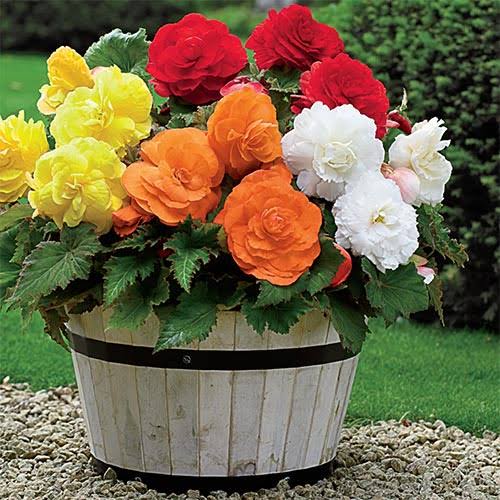
Multi flowering fringed begonia look remarkably like the more flamboyant varieties of carnations, but will yield more flowers set closer together and over a much longer period of time. They put on a glorious display all summer long blooming from summer onwards. They work great in hanging baskets, borders or just indoors in large pots on a sunny location.